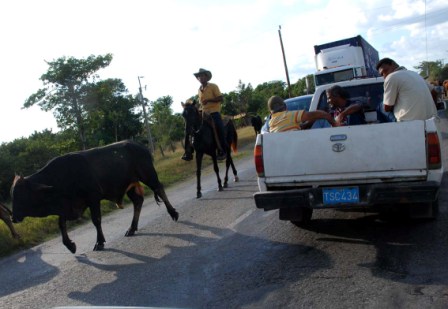Fast and Furious
Yenisel Rodriguez

Today I want to illustrate an issue that has been widely discussed in the Cuban media: highway traffic accidents associated to the frequent use of private trucks.
This service allows people who live in neighboring provinces to connect with each other. From province to province a national transportation option spontaneously appears, and I recently traveled 40 percent of the country in this manner.
I can testify to the danger of these trips first hand – danger due basically to the irresponsibility of the owners and drivers of these trucks designed for freight. These individuals — in search for greater profits and motivated by the high demand for their service — drive these vehicles up to their maximum speeds, despite the fact that they are more than 50 years old on the average.
There exist certain routes where the situation is more problematic. This is the case of the inter-municipal route between El Cobre and Santiago de Cuba, within the province of Santiago. On this journey you can find yourself careening down narrow country roads at speeds of more than 50 miles an hour. During my travels through that area I witnessed a horrendous accident: a little girl lost her left arm when the truck she was riding in came too close to a pick up truck going in the opposite direction.
Once before I had been “spared” from a potentially horrific collision between two trucks while in Ciego de Avila province. I remember that because my family in Havana discovered yet another reason to worry about my Marco-Poloesque ventures.
Another extremely dangerous route is the one that connects the provinces of Santiago de Cuba and Guantanamo. Here, though they do indeed drive at breakneck speeds, what’s worse is the fact that the roadway curves around dozens of ravines and cliffs.
Many passengers, despite having used this truck-transport service for years, still today are unable to adapt to the eminent danger suggested by inter-provincial transportation on private carriers.
What comes to mind is the comment made to me by the parent of a friend of mine in Santiago de Cuba. She said, “We never travel together. If by chance we run into bad luck and a truck crashes, at least one of us will survive to take care of this house, which one day will be Alfredito’s (my friend).”
Imperceptible at first, daily uncertainty is felt by thousands of people who routinely travel between the country’s provinces and municipalities. Generally, these are people with few material resources, and therefore they’re unable to afford the luxury of government inter-provincial bus transportation, which is a little safer.
I remember descending the steep La Farola “highway,” an extremely narrow arterial that skirts the mountains.
Dismayed, I observed how the locals suddenly stopped their joking and conversations to pause in infinite contemplation of what was to come: an hour-long descent, zigzagging through the night in the rain while depending on our drunken sleep-deprived driver to not do anything stupid.
As for me, I clung tightly to the closest rail with the naive hope that this position would somehow save me from the imminent nosedive. Fortunately everything turned out okay, although the pain in my wrists lasted longer than I expected.





